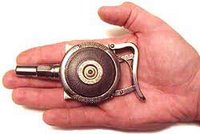Hell in a Handbasket has a great post on collecting and shooting old guns. He mentions his Krag rifle has finger impressions probably left by a scared soldier fighting in the Spanish-American War. Now that’s a connection to the past. His post inspired me to try to put into words why I love to collect guns.
Ages ago in blog-time, I talked about collecting guns. I mentioned collecting. I talked about our criteria, the fact that I have a Curio & Relics license, and that I once worked in a museum and have taken apart, cleaned, conserved, and reassembled many guns. But, I didn’t talk about my passion that lies behind collecting guns.
First and foremost I love shooting. I’ve been doing it almost my entire life. I regularly shoot rifles, handguns, and shotguns. I’ve rented and shot submachine guns. I’d love to shoot a crew-served heavy machine gun and one of these days I will.
I love how guns are put together. I never get tired of taking a gun apart and seeing how a gun maker decided to make this particular design work. He labored in a field constrained with patents belonging to other people, material science, physics, ballistics, and a whole lot more. Each gun maker solved certain problems to ensure his gun design worked. One maker, like Luger, decided that a toggled slide would work best in a semi-auto while another, like Browning, decided that a reciprocal slide would work best.
Because of these constraints, guns come in an almost infinite variety while still maintaining their form and function. Most handguns, for instance, have a grip, a barrel, and a trigger. Within those parameters you will find revolvers, semi-autos in a bewildering variety, pen guns that don’t even have a grip, derringers and so many more.
The same thing's true with rifles and shotguns, though with less outward variety. A long gun must fit the human shoulder, arm reach, and hands while a handgun must fit only the hand. That’s not to denigrate the variety of long guns. They have straight English stocks, semi-pistol grip, pistol grips, fore ends that go all the way to the muzzle, splinter fore ends that are barely there, and more action types than you have time to read about.
In this post, I’ve mentioned shooting, fascinating mechanisms, and variety, but there’s another reason why I love to collect guns. It’s what Hell in a Handbasket covered so well--that connection with the past. For example, I recently bought a Steyr-Hahn. I shelled out my hard-earned money for something I’ll never use as a self-defense weapon. I certainly won’t target shoot with it and I’ll probably shoot one box of ammo out of it while I own it. It’ll spend more time in the safe than it ever will in my hand.
But I bought it because it connects me to history. It was once the sidearm of the Austro-Hungarian Empire, which ruled my ancestors. It was put into service in 1917, during World War I, the War to End All Wars, only it didn’t. I don’t know who used it, if he ever shot it in anger or fear, but it’s a palpable connection with my past and with human history. I pick it up, or one of my Lugers, or my M1 Garand, or Bill’s Enfield and I can better understand history. Hefting them, loading them, shooting then, and feeling their recoil helps me understand what our ancestors experienced.
I studied history in college and graduate school and I make my living now helping to preserve today’s history for future generations. Thus, it’s no surprise that I feel such a connection. A handful of my colleagues don’t want to understand it. One of them once said that he wouldn’t even touch a gun because “they’re made to kill.” I point out to these naysayers that mankind rose from the swamps only because of our ability to make weapons and other tools. They can’t understand that a weapon is just another tool.
My love of guns is a connection with the past. I plan to ensure that my collection is available for future generations and that those generations are able to shoot and collect guns. They too can touch a part of that which makes us human.


No comments:
Post a Comment